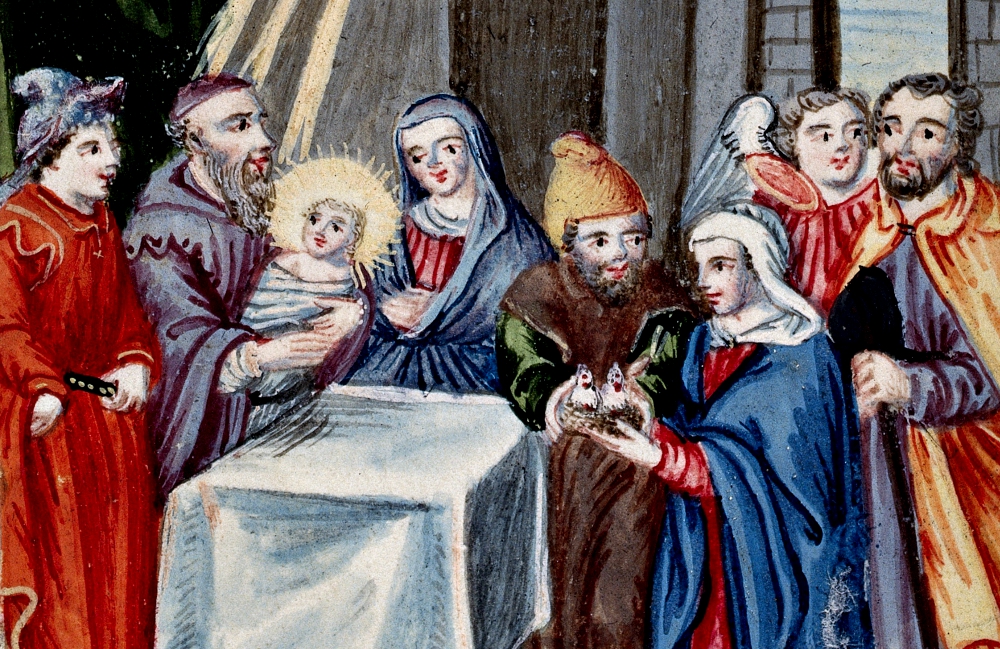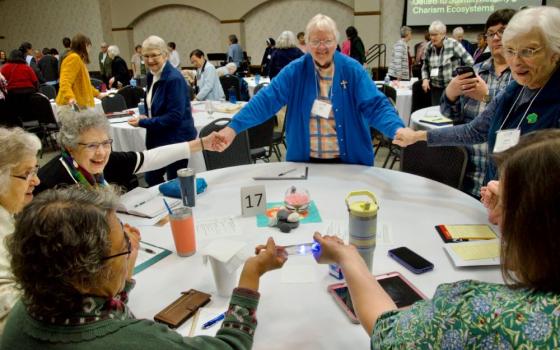
Detail of a 16th-century miniature of the Presentation of Jesus at the Temple (Wellcome Collection, CC BY)
By now, most of the tinsel has long been stripped away. Fairy lights have been unwound and packed up, and even the most stalwart Christmas trees dragged out to meet an ignominious end on the curb. Eggnog and wassail have been retired in favor of wholesome, plant-based, notably less booze-and-cream-drenched New Year's resolutions.
In other words, Christmas is over. It is several weeks over, and has been over ever since radio stations switched abruptly from-round-the clock Dean Martin to generic pop hits at the stroke of 12 on Christmas night.
The sudden change is like a door banged shut in your face. It leaves a hollow feeling inside you: all that preparation, all that anticipation, all that excitement, and for what? A frenzied climax of less than 24 hours, a celebration that always contains the possibility of disappointment, simply because its fleeting nature makes it subject to impossible expectations.
Ostensibly, of course, we solve this problem by extending Christmas backward, all the way toward Halloween. But it doesn't really work. For one thing, the conflation of the Christmas season with the period of preparation preceding it benefits no one but retailers. The Christmas feast becomes associated with business, rather than rest, and all Christmas merriment and cheer is telescoped and oriented toward the morning ritual of presents under the tree.
For another thing, Christmas in the fall brings cheer to a season that doesn't need it. We are still basking in the harvest plenitude of Thanksgiving when Christmas lights begin to show up. But it's in January, as bleak midwinter sets in for what feels like an eternity, that we need to be reminded of the light.
But I am no Scrooge, no Grinch, no Mr. Potter. I come to praise Christmas, not to bury it. I do not want to curtail the season, merely shift its temporal window.
Of course, the Incarnation is for all people, and all times, and so it can be celebrated whenever and however we choose. People on sunny Australian beaches have just as much right to Christmas as those of us shivering in Dickensian gloom.
But feasts are for the people, and they take their shape and poignancy from the lives of those who celebrate them. A thousand different ways to enjoy the church calendar have developed around the world, each one offering its own gloss on the universal mysteries, each one highlighting a different aspect.
I propose that for those of us for whom winter is marked by shadows and chill, Christmas is a festival of the light that shines in the darkness.
Advertisement
Arriving at the height of winter's decay, it offers little enough by way of refuge: the fulfillment of a few enigmatic prophecies; one star, dazzling a darkness that nevertheless persists. But how tangible and real is the refuge: a warm, living baby, an unmistakable celestial rumpus, and the pleased lowing of animals, who, folklore tells us, are the first to know when something big is on the horizon.
Christmas is not the feast of victory, of transcendent restoration or solemn peace. It is the heartening of a people for whom the tide has just turned. The murkiness that shrouds the first stirrings of renewal — of the year, of the liturgical cycle, of the human epoch, of the human soul — receives its full due at Christmas, but murk lends all the more urgency to merriment.
Given all this, I believe it makes sense to celebrate Christmas not from Oct. 31 to Dec. 25, or even from Christmas Day to Epiphany. Instead, let's hunker down with our lights and candles, our rum cake and evergreens, from Christmas Eve all the way through February.
There is precedent. It used to be the custom in many countries to end Christmas on the feast of Presentation of Jesus, on Feb. 2. The feast was called Candlemas, and families would bring their candles to church to be blessed. All the candles in the house might then be lit, and the Nativity scene finally put away.
It's a beautiful way to close the season honoring the light of the world, and I propose that we revive the custom. Let's make Dec. 25 the beginning of the Christmas feast, rather than the anticlimactic end. Let's put off the holiday frippery and Christmas parties during Advent, but hold on to them all the way through the icy blasts of January.

(Unsplash/Davidson Luna)
I realize that this may be a somewhat quixotic quest. After all, our current official liturgical calendar ends Christmas firmly on Jan. 8. But again, feasts are for the people. If the laity shifts its Yuletide celebration, the hierarchy will follow.
On the other hand, it is possible that I continue to be a stubborn holdout, watering my tree while my neighbors pack up theirs, and sending Christmas cards in mid-January. It is possible that my proposed revision of our cultural calendar never catches on, and remains a mere personal eccentricity.
But at the very least, we should begin to celebrate Candlemas again. What a beautiful scene it is: a young family, a postpartum mother perhaps still weary from the ordeal that the Nativity must have been for her. They present two turtledoves, the offering of the poor. And then, a glow of recognition in Simeon's eye, as he realizes that what he has been waiting for his whole life is before him, tiny and fragile.
"Lord, now you let your servant go in peace; your word has been fulfilled: my own eyes have seen the salvation which you have prepared in the sight of every people: a light to reveal you to the nations and the glory of your people Israel."
It is a scene of deep, warm, spreading joy. It is a joy we need right now, as looming nuclear war, irreversible environmental damage, and entrenched sexual predation dominate the news. Simeon saw the fulfillment of God's promise, and we will as well. We are emissaries of the Prince of Peace, and we bear candles lit with his everlasting light.
[Clare Coffey lives in the Philadelphia area. She teaches kindergarten at a small Catholic school.]
Editor's note: We can send you an email alert every time a Young Voices column is posted to NCRonline.org. Go to this page and follow directions: Email alert sign-up.





